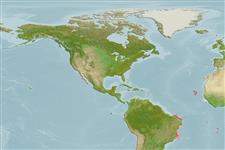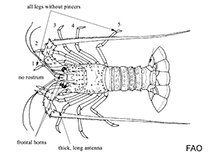Panulirus echinatus Smith, 1869
Brown spiny lobster| Native range | All suitable habitat | Point map | Year 2050 |

|
| This map was computer-generated and has not yet been reviewed. |
| Panulirus echinatus AquaMaps Data sources: GBIF OBIS |
Upload your photos
Google image | No image available for this species;
drawing shows typical species in Palinuridae.
Google image | No image available for this species;
drawing shows typical species in Palinuridae.
Classification / Names Common names | Synonyms | CoL | ITIS | WoRMS
Malacostraca | Decapoda | Palinuridae
Environment: milieu / climate zone / depth range / distribution range Ecology
Benthic; depth range 0 - 35 m (Ref. 4). Tropical; 30°N - 21°S, 42°W - 5°W (Ref. 4)
Distribution Countries | FAO areas | Ecosystems | Occurrences | Introductions
Atlantic Ocean.
Length at first maturity / Size / Weight / Age
Maturity: Lm ? range ? - ? cm Max length : 39.0 cm TL male/unsexed; (Ref. 441); common length : 39.0 cm TL male/unsexed; (Ref. 4); common length :38 cm TL (female)
Total body length: 7 to 39 cm (male); 5 to 38 (female). Carapace length: 3 to 19 cm (male); 2 to 15 cm (female); 5 to 10 cm (ovigerous females; Ref. 4). Occurs at depths from 0 to 35 m, but usually not deeper than 25 m and lives in crevices in rocks, among boulders (Ref. 4). Prefers offshore regions (Ref. 81730). Nocturnal (Ref. 4). Generalist feeder (Ref. 101626).
Life cycle and mating behavior Maturity | Reproduction | Spawning | Eggs | Fecundity | Larvae
Members of the order Decapoda are mostly gonochoric. Mating behavior: Precopulatory courtship ritual is common (through olfactory and tactile cues); usually indirect sperm transfer.
Main reference
References | Coordinator | Collaborators
Holthuis, L.B. 1991. (Ref. 4)
IUCN Red List Status (Ref. 130435)
Least Concern (LC) ; Date assessed: 03 December 2009
CITES status (Ref. 108899)
Not Evaluated
CMS (Ref. 116361)
Not Evaluated
Threat to humans
Human uses
Fisheries: commercial
| FIRMS (Stock assessments) | FishSource |
Tools
More information
Internet sources
BHL | BOLD Systems | CISTI | DiscoverLife | FAO(Publication : search) | Fishipedia | GenBank (genome, nucleotide) | GloBI | Gomexsi | Google Books | Google Scholar | Google | PubMed | Tree of Life | Wikipedia (Go, Search) | Zoological Record
Estimates based on models
Preferred temperature
(Ref. 115969): 20.3 - 27.5, mean 27 (based on 129 cells).



